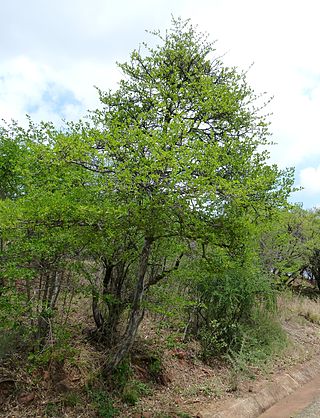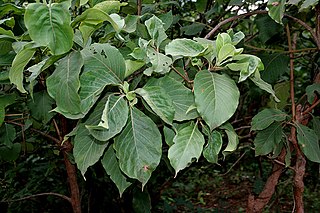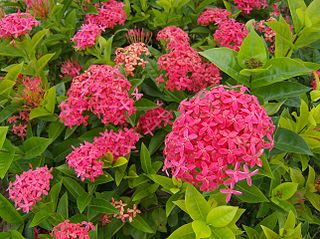
The Rubiaceae are a family of flowering plants, commonly known as the coffee, madder, or bedstraw family. It consists of terrestrial trees, shrubs, lianas, or herbs that are recognizable by simple, opposite leaves with interpetiolar stipules and sympetalous actinomorphic flowers. The family contains about 13,500 species in about 620 genera, which makes it the fourth-largest angiosperm family. Rubiaceae has a cosmopolitan distribution; however, the largest species diversity is concentrated in the tropics and subtropics. Economically important genera include Coffea, the source of coffee, Cinchona, the source of the antimalarial alkaloid quinine, ornamental cultivars, and historically some dye plants.

Canthium is a genus of flowering plants in the family Rubiaceae. They are shrubs and small trees. The leaves are deciduous and the stems are usually thorny.
Afrocanthium keniense is a species of flowering plant in the family Rubiaceae. It is endemic to Kenya. It is threatened by habitat loss.
Keetia is a genus of flowering plants in the family Rubiaceae. It consists of climbers or scrambling shrubs, rarely small trees.

Lagynias was a genus of flowering plants in the family Rubiaceae but is no longer recognized. In 2005, it was sunk into synonymy with Vangueria, based on a phylogenetic study of DNA sequences.

Psydrax is a genus of flowering plants in the family Rubiaceae. It consists of trees, shrubs, and a few lianas in the paleotropics.

Pyrostria is a genus of dioecious flowering plants in the family Rubiaceae. Most of the species are endemic to Madagascar, others occur on islands in the western Indian Ocean, a few are found in continental Africa, and only six species occur in tropical Southeast Asia. The formerly recognized genus Leroya, containing two species endemic to Madagascar, L. madagascariensis and L. richardiae, was sunk into synonymy with Pyrostria.

Vangueria is a genus of flowering plants in the family Rubiaceae. The genus is named for Voa vanguer, as V. madagascariensis is known in Malagasy.

Vanguerieae is a tribe of flowering plants in the family Rubiaceae and contains about 655 species in 30 genera. It is one of the most species-rich groups within the family and it is distributed across the Paleotropics.

Afrocanthium is a genus of flowering plants in the family Rubiaceae. It consists of deciduous, unarmed trees, and shrubs. They are native to East Africa, from Sudan and Ethiopia to South Africa.

Hymenodictyon is a genus of flowering plants in the family Rubiaceae. It has about 30 species. All are native to the Old World. The wood of Hymenodictyon orixense is soft and has limited use, mostly for boxes. The type species for Hymenodictyon is Hymenodictyon orixense.

Canthium armatum is a species of flowering plants in the family Rubiaceae. It is a shrub or tree native to southern Mozambique, Eswatini, and KwaZulu-Natal and the Northern Provinces of northeastern South Africa. The species is characterized by the presence of large spines.

Meyna is a genus of flowering plants in the family Rubiaceae.
Fadogiella is a small genus of flowering plants in the family Rubiaceae. It was described by Walter Robyns in 1928.
Ancylanthos was a genus of flowering plants in the family Rubiaceae but is no longer recognized. It was originally described by René Louiche Desfontaines in 1818. In 2005, it was sunk into synonymy with Vangueria, based on a phylogenetic study of DNA sequences.

Pyrostria revoluta, formerly Scyphochlamys revoluta, is a species of flowering plant in the family Rubiaceae that lives on the island of Rodrigues.
Pyrostria verdcourtii is a species of flowering plant in the family Rubiaceae. It is a tree endemic to Madagascar. It was first described as Neoleroya verdcourtii in 1971 and placed in the monotypic genus Neoleroya. In 2007 it was sunk into genus Pyrostria as Pyrostria verdcourtii.

Ixoroideae is a subfamily of flowering plants in the family Rubiaceae and contains about 4000 species in 27 tribes.
Buckollia is a genus of plants in the Apocynaceae, first described in 1994. It is native to eastern Africa.












